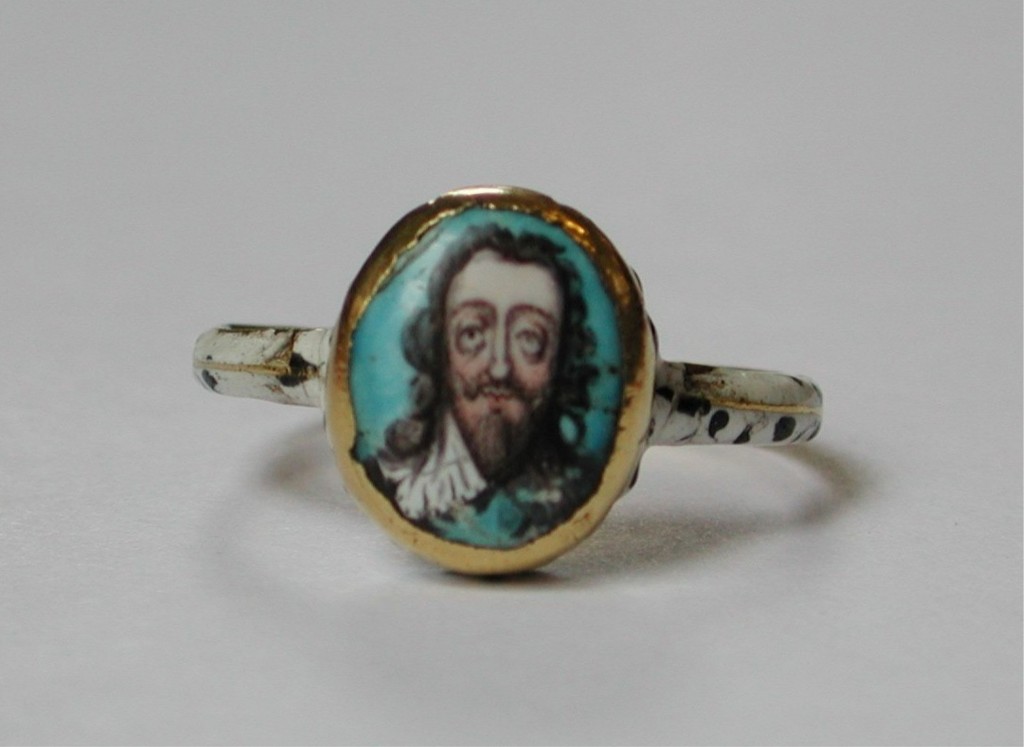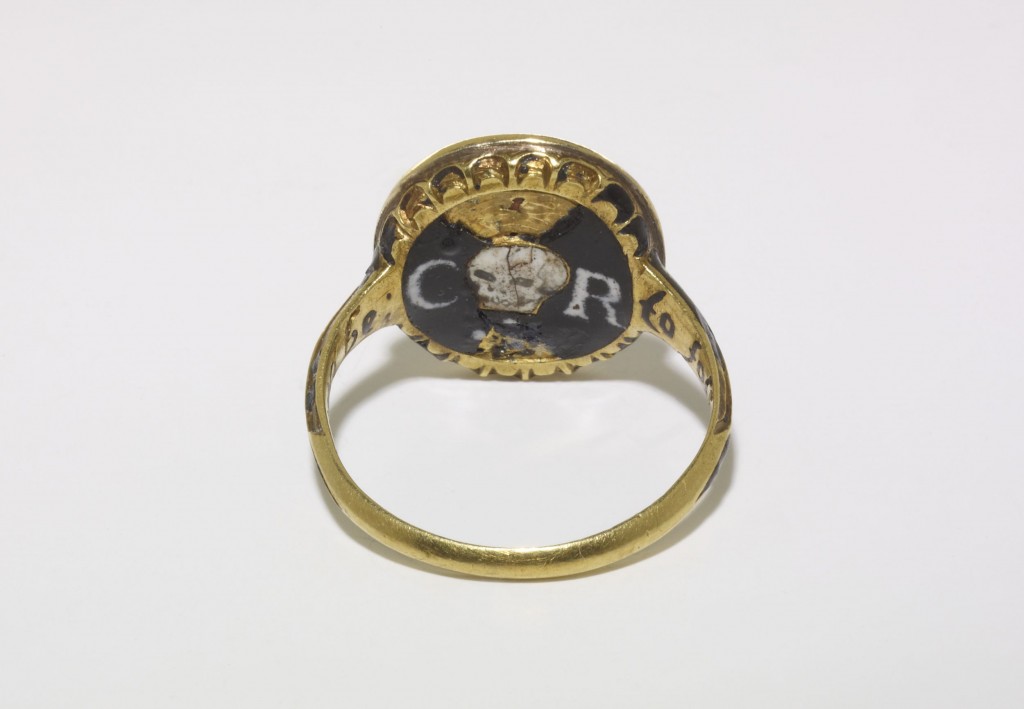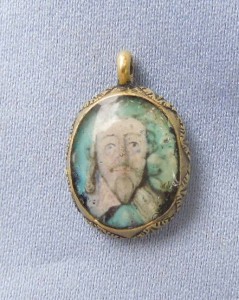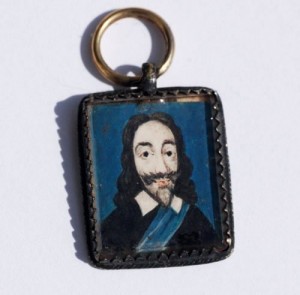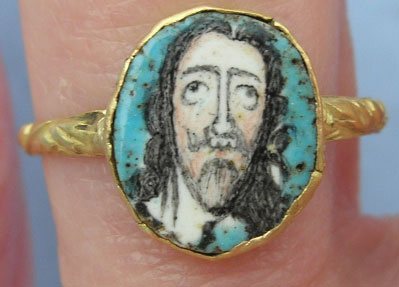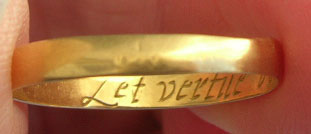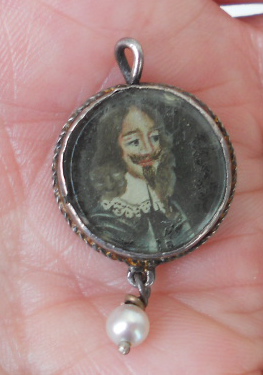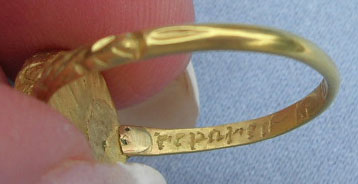Memorial Ring Commemorating Charles I
Secrecy and devotion are intrinsically linked. Without the elements of love and fidelity that connect people, there is no honesty and relationship to grow upon. This works in the interpersonal relationship, just as it does through devotion to a leader. One needs to have a set of values to unify with another and those values aren’t necessarily something that must be overtly stated. The message of today’s Charles I mourning ring is two-fold. On its general appearance, it is a mourning ring. When it is open to reveal the image of Charles, the piety and devotion of the wearer to the crown is apparent. This is important to note, as the ring itself could be worn in public and the wearer would be considered in mourning, through the black enamel, but its genuine message is a further statement, during a time of social and political tension.
Charles I jewellery was created after his death as commemorative pieces, but some were created during the time; much of the smaller design elements can be judged for the jewel’s proximity to his actual death. Royalists wore pieces such as these are noted for their use of a locket to hide the portrait of Charles, keeping the wearer loyal, yet safe. Here, the ring is centred with a large diamond and flanked with black enamel, which shows that it was quite an expensive piece for its time.
In the use of the black enamel, death is signified. its mix of Broque and Moresque design to create the floral elements is elsganity balanced, continuing with the raised bezel, which was typical for mid-late 17th century rings. The Moresque style derives from the term “Moorish” in English, and is applied to art styles of the 16th and 17th centuries, seen in jewels with the elaborate patterns which take on a floral nature. While its appearance was essentially derived from Islamic ornament, its history goes back to the Roman grotesque decorative style, which had also developed in illuminated manuscripts through the Middle Ages. Human and animal forms become geometric or appear as foliage decoration, or as described in 1611 by Randle Cotgrave as: “a rude or anticke painting, or carving, wherin the feet and tayles of beasts… are intermingled with, or made to resemble, a kind of wild leaves…” (A Dictionarie of the French and English Tongues).
Death is about identity. Having a memory of someone is the crucial element of their continuing existence through a network of people. Without this identity, they would not continue to be, which is why mourning symbols are so integral to the connection of the person to their memory and how these symbols were worn in public denotes that the person wearing them was in mourning. It is a connection of people in love through the use of fashion to represent memory and identity.
Charles I was incredibly important to the nature of mourning symbolism, so much so, that his identity created the essential elements for the mourning industry post-Restoration period. Having jewels that represented the deceased king went beyond royalist thinking and related directly to the nature of death as a symbol. A person wearing a Charles I jewel could dedicate one towards another, just using Charles I was enough to denote status in society and the sentiment between the two could be solidified. Look to this ring with the black/white enamel around the band using the dedication of “The gift of Mr. Roger Jones”, which was probably a later dedication:
And on the other side of Charles I mourning jewels, there is the historical element. Charles I was beheaded on the 30th of January, 1649 (Julian calendar), creating a division within society that resonated throughout British generations. This ultimately led to a parliament holding more power than before in the reinstatement the crown through his son, Charles II, but symbolically, the monarchy was the conduit for the crown and religion. As a symbol, Charles I becomes a martyr for the identity of these elements; his very death, regardless of popular or not, can be used by monarchists to justify the monarchy itself. He died and what followed was the Puritan period of Oliver Cromwell who became Lord Protector of the Commonwealth of England, Scotland and Ireland, who can be vilified or appreciated for his reign, but through the iconography of Charles, was ultimately demonised.
In this example of a fine Charles I mourning ring, the elements of his iconography are established. The royal blue enamel is in the background (which will be discussed later) and Charles is in the foreground, with his eyes turned towards the heavens. This denotes the post-mortem nature of the Charles pieces, otherwise his eyes would be looking forward and this would be during his reign.
Utilising the memento mori skull with “CR” upon the reverse shows the piety towards Charles and also shows how the elements of mourning had become engrained within society. Black enamel was the primary identifier for death and the memento mori symbols were now appropriated for the basic sentiment of death. As a ring for a royalist, this memorial ring was made to show how the wearer connected their political sentiments back to the crown and that this was something they were proud to establish. This was a royalist piece for the very nature of being royalist. What is interesting is that Charles was as familiar to the people who wore these rings as a family/friend who had passed on. There is more sentiment in what was quite an expensive jewel to be worn as a symbol of identity for the crown, than was created for that of loved ones. Indeed, loved ones in the 17th century did not have the luxury of easily accessible miniatures to depict them, rather the cypher or monogram were more popular to be used, woven in gold or base metal to convey the sentiment.
I don’t think there’s enough that I can say about these Charles I pieces. To me, they represent the inception of an industry that certainly was on the verge of being one of the most culturally important movements in modern history, due to its cross-cultural pervasiveness and obvious necessity. Yes, I’m talking about the industry of mourning.
However, there is also the way that death was adapted by the oncoming industrial revolution and the inception of social movement. In some ways, the affectation of mourning speaks about the superficial nature of the human condition, with our fickle concerns of outward presentation and adherence to human-imposed social conventions.
What has this to do with the Charles I pendant on display here? The beheading of Charles I created a royalist movement that provoked society to adapt tableaus in dedication to the fallen king, with a disregard to the monetary context of the dedications – surviving portraits of Charles may vary in quality from the finely painted to the naive. However, there is quite an effort to present the man with respectful quality, regardless. This royalist movement was one that could transcend the socio-economic demographic and allow for the lower classes to express their grief/loyalty (even when the pieces were covered or hidden in lockets), as opposed to more insular cultural outlooks, which focused more on the immediate family/work paradigm without the greater social awareness. Communication was becoming faster, social borders were crumbling and the presentation of the self to this greater social audience was becoming more and more important.
Hence, when a piece like this was worn, albeit enamel side up (the pearl is a later addition), it still conveys a message about the wearer to the society around them. It shows obvious status and wealth.
Looking at the piece itself, Charles is looking off (not engaging the viewer) with sadness, hence its meaning as being a royalist piece is established (hardly the demeanour of a king still alive), the portrait itself, shows the face is painted to a pre-established ideal of the king and not painted in personal company with the man himself though the miniaturist has taken careful detail to shading of the hair and attention to the costume – often portraits of Charles would be closer in to the face of the subject. On the reverse, we have the blue enamel and this side doesn’t demand that the wearer turn it over to reveal the portrait. In this case, the portrait is personal and worn over the heart, while this enamel reverse can be presented with all the sophistication of class status that it deserves. If the wearer commissioned the blue enamel with the intent of royalty in the face of such a personal sentiment is truly the prerogative of the person who commissioned it, however, it is more likely. The piece is set in silver and retains much of the popular late Baroque design in the flower and enamel that would be expected.
Charles I was born on the 19th of November, 1600 and executed on the 30th of January 1649, facing a tumultuous rule which temporarily ended the monarchy in England. His death would spark a Royalist movement that would lead to the rise of the mourning industry in jewellery; creating the affectation of wearing a jewel for sentimental purposes – a jewel that was accessible for all classes and not relegated to the aristocracy. It also bought an immediacy to mortality, questioning the very principals of religion and final judgement.
Definition
Due to the lack of standardisation of the portraits at the time and the class-transcending need of the king’s portrait for Royalists, many variations of the Charles mourning miniature exist. Some range from being naive to incredibly detailed. For others, they were created as studies after the Restoration, leveraging their portrait based upon other studies of Charles I.
One way to look through the mix of different Charles I portraits is the date on the reverse. The Royalist would mark this date as a fundamentally important one; it marked the end of the monarch and the establishment of the Commonwealth of England.
Whilst history documents the monarch’s execution on the day of January 30, 1649, the date 1648 on other pieces are based on the Julian calendar, which was used in England until the 18th century. Using the Julian calendar, the year did not commence until March, so many contemporaneous mourning pieces record the execution as having taken place in 1648. Other than the date, the eyes of the king are the second most important factors to note for modern collectors. The eyes, facing up, were created for the purposes of mourning or memorialising Charles, as the eyes are looking towards the heavens. The background is another factor, with some pieces showing dark colours behind the king to denote death. Blue, often a colour to denote royalty, was one of the most popular colours to be shown in the background, as can be seen by the following pieces:
As there was no true standardisation, apart from the image of the king, these rings, lockets and pendants have a remarkable variety. This variety shows what part of society would have wanted to wear the jewel and shines a light on just how resonant the Royalist movement was. Some are base metals or silver, others gold with more interesting design motifs. In this pendant, we see the designs around the border, showing a Baroque design that doesn’t allow for a true oval shape, but undulates the shape with the flourish.
Sentimentality in the Early/Mid 17th Century
Sentimentality in the early 17th century had changed dramatically from the 15th century, with the 16th century being a time of greater social movement and influence of the interpersonal relationship. Jewellery, by its very nature, is sentimental; worn for affection, or to gain affection. This can be seen in the rise of the mourning ring being an item that would be factored into a will and also the ubiquity of the posie ring.
Posie rings, otherwise known as ‘poesy’, ‘posy’ or ‘posey’, are one of the primary catalysts for the mourning and sentimental rings that generated their own industry post 1680.
Without the standardisation of the English language and the written reliance on Latin previous to the dictionary in 1755, posie rings are a remarkable time capsule for phonetically capturing their surrounding language in a jewel. From a status perspective, this utilisation of language is accessible to a strata of society that didn’t have the luxury of formalised education, opening up sentimental jewels to new levels of society. Basic sentiments of love etched into silver and gold bands could now be given as a secret love token for a growing middle class. In rings previous to the 16th century, more common would be the inscriptions written in French, Latin and Norman French.
Chapbooks, pamphlets containing popular literature, were a popular source for many of the sentiments written inside the posie rings. These cheap pamphlets grew in popularity, as they were sold cheaply (commonly a penny or halfpenny) and contained many popular ballads from the time. This pre-dates mass produced media of the early 19th century, when steam presses led to the rise of cheap newspapers. From the mid 16th century, these cheap and crudely produced booklets contained relevant popular content that varied from entertainment to political and religious content. Here, the relation of the ring to the popular literature is the key factor in understanding just how the posie’s relation to society. They were jewels that could be for the commoner, but also transient as a style of love token through society because of their simple statements.
Look towards the nature of hair and its status as a gift in jewellery from the 17th century. Prior to the rise of the hairworking industry and its prominence in mainstream jewellery, gifts of hair were considered tokens of affection and love between two people. Bury refers to The Relique (or The Relic) by poet John Donne (1572-1631) and its very early reference to a hair bracelet:
“When my grave is broke up againe
Some second ghest to entertaine,
(For graves have learn’d that woman-head
To be to more than one a Bed)
And he that digs it, spies
A bracelet of bright haire about the bone,
Will he not let us alone,
And thinke that there a loving couple lies”
Donne speaks in metaphysical terms about the unifying nature of spiritual love, as when he and his lover are dug up, they remain the symbol for holy and eternal love. From this, the poem is an excellent perspective on the sentimentality of hairwork at the turn of the 17th century. Wearing hair was an encompassing symbol of union and love between two people.
Donne wasn’t unique in his wearing of a hair bracelet, however, as Count de Grammont viewed several people wearing hairwork bracelets in the Court of the restored Charles II, circa 1660. This ties in with the rising prominence of other sentimental jewellery at that time. From love tokens, such as posy rings, to hair woven under crystal in slides, brooches, rings and other forms of jewellery, sentimental jewellery was rapidly evolving over the 17th century. Within these forms of sentimental jewellery, the use of hair became ever more prominent. Another example from 1647/8 of the popularity of hairwork within mainstream culture can be seen in Mary Varney’s letter to Sir Raplh Varney, asking to send locks of their daughter’s hair “to make bracelets? I know you could not send a more acceptable thing than every one of your sisters a bracelet”. At the time, Ralph was living in exile in France during the Protectorate. Hair tokens within families was the more common practice, but as jewels grew as a social device, so did their nature as a personal statement.
Indeed, the period surrounding Charles I was steeped in the growing sentimental culture, bolstered by Charles II and his support of the arts. Fundamentally, however, the act of having a keepsake of a loved one was intrinsic to the self. This influence of the human being important was born from religious challenge at the time.
Charles I, Challenges and Religion
Charles I’s reign was faced with great conflict, the combination of which would lead to his execution. Married (by proxy) to the Catholic Henriette Maria at Notre Dame de Paris, there was an internal concern of Charles wanting to repeal Catholic restrictions. During the 1620s, there was much friction between the Catholics, Calvinists, Puritans and Anglicanism, which led into the external fear from foreign conflict that threatened cultural thought through protection. The kingdom was challenged by other cultures which could actively take over England and that would lead to a society threatened.
Money was an incredible hardship of Charles I’s reign, leveraged by the deficit from Elizabeth I onwards. Regulation of finance by parliament led Charles to focus upon taxation. The need to gain revenue was intrinsic to the continuity of the kingdom, which would counter legislation, but provide protection of the kingdom. The tonnage and poundage collection of taxes for royal collection provided a great deal of debate.
The Thirty Years War had spread, which led Charles to declare war on Spain (where Philip IV had defeated Emperor Ferdinand II). This was to be a relatively low-cost naval attack on Spanish colonies in the New World. Charles moved inland at quite high expense, but was not given funding required by parliament, only imposing more regulation on wartime expenditure upon him with annual review. In the House of Lords, the Duke of Buckingham had not passed the bill, who was supported by Charles. This led to much dissension in parliament of contention towards the Charles’ supporting of Buckingham, leading to their dismissal at Charles’ request. Buckingham had led a failed incursion against Spain only expedited this negative faith in his leadership. After a misguided assault on the French coast by Buckingham to defend the Huguenots at La Roche, the goodwill of the king’s marriage to a French princess was strained and in 1628, Buckingham was assassinated.
Debate over the tonnage and poundage issue had begun in parliament, based around an MP who had failed to pay the cost. Much reaction came about this, and its factor towards Charles, leading towards further religious debate that led Charles to dissolve Parliament (arresting nine parliamentary leaders). This began Charles’ personal rule for eleven years, where he found peace with France and Spain.
The closing of Puritan organisations and dismissing non-conformist clergymen by the Archbishop of Canterbury, William Laud, in 1633 threatened other religions that were not the Church of England. The Book of Common Prayer became the authorised sacrament, with punishment to those who countered it. In Scotland, however, this would prove to be a mistake, as the book was instituted without consulting the Scottish Parliament or the Kirk, where it was seen as another element of dominance by the Church of England. The Church of Scotland had denounced the book in 1638, causing Charles to march on Scotland, thus began the First Bishop’s War.
Much of Charles’ issues in the war were drawn to the parliament and the lack of funds needed to create a successful campaign. Charles attempted to buy time in 1640 by calling the Irish and English Parliaments for more funds, but only the Irish offered a subsidy of 9,000, while the English Parliament was at loggerheads. Conflict would continue with the Scottish until Charles summing the Long Parliament, which assembled in 1640.
The Long Parliament began to impeach the king’s councillors for high treason for its right of being, which lead to the Triennial Act which meant that the king needed to summon Parliament at least once every three years, otherwise, other authorities could summon Parliament. In 1641, the dissolution of the English Parliament without its consent was deemed lawful. Once again, the tonnage and poundage act came into factor for high taxation, making Parliament rebel. The Irish and English Parliaments were challenged by the influence of the Protestant land ownership in Ireland, leaving Charles to have a lesser influence in Ireland. The Grand Remonstrance, a list of grievances against action by Charles’ ministers since his reign began, was passed in the House of Commons in 1641, leading to a breakdown in relations to the Irish Parliament and faith in Charles’ rule. The Irish rebellion needed funds, and Charles requested this from the Parliament, but fear led to the Militia Bill, which was a request to gain the army from the king.
Charles was quickly losing power, with even rumours that his Catholic wife about to be impeached. With the invading Scots being a threat, five members of Parliament were suggested to have colluded with them. Charles stormed Parliament and was embarrassed to have he five members fled.
In 1642, Charles raised an army, while Parliament called for a militia. The first major battle in the First Civil War was the Battle of Edgehill. Various skirmishes happened until the Battle of Naseby, where Parliament got sure footing. From this point, the Scots withdrew and the king was in custody until his execution.
From the pressure that led to Charles’ demise, it shows that the outlook of the populace wasn’t based in the faith of one monarch, but the challenge that came from eternal cultures. With influences from the Scottish, Irish and Europe, England was in a space where it needed to quantify its measure of belief, rather than put its faith in a ruler which had previously created divine protection.
Jewellery in this time became more of a necessity for personal relationships, Jewels were now the measure of the life and love of the person who wore them. Rather than being a token of status in society, they were a token of the self.
This piece dedicated to Charles I is a display of affection that would eventually generate the popularity of the mourning custom. Looking at the piece, Charles’ eyes are turned upwards, which confirms the piece was created after his death. Pieces of this quality are historically important for their relevance to English history and in mourning jewellery. Incredibly rare, other examples can be seen in the V&A Museum. Though there is repair work to the shank, the style of the ring is a good indication of the mid 17th Century.
Rings of the time, particularly after the death of Charles I in 1649, used much of the memento mori symbolism (more on that in another post), but the difference of putting the portrait of Charles I (above), or pieces with the initials CR, shows a distinct change of memento mori as a statement to one of reverence.Note that Charles’ eyes are facing upwards, which denotes the death of the subject. Earlier portraits (during his lifetime) had the eyes facing forward. These eyes are looking to the heavens. Pieces like this were created during the royalist movement (and beyond) and would eventually spur on the English Restoration leading to the instalment of Charles II.
Mourning bequeathments had been in popular thought since the late 16th century, but became indoctrinated through the 17th century. Most famously, William Shakespeare in 1616 declared that in his will that his daughter and wife should have rings stating “Love My Memory”. He also details a donation of rings to three (such as Burbage]) of his acting colleagues.
Samuel Pepys bequeathed 123 rings upon his death in 1703. These rings were graded into three classes and given out according to proximity of friendship and social status. So typical as a token of giving at a funeral, Pepys wrote in his diary:
“This day my Lady Batten and my wife were at the burial of a daughter of Sir John Cawson’s and had rings for themselves and their husbands.” – July 3, 1661
The period of the second half of the 17th century was the time of the Restoration of the British Crown and a time when industries were growing to accommodate a growing middle class through technological advancements. Through this, the custom of highly produced rings led to cheaper cost. Robert Walpole, Earl of Oxford, died in 1700 and bequeathed 72 rings at £1 each to friends and family, based on the same principles as Pepys.
The token of a mourning jewel as a device of remembrance becomes ingrained within a realm of society that had not needed a standardisation of a token of remembrance (as defined by court), but the thought had seeded its way into society.
This custom, though used, was not as popular as the latter half of the 17th Century would prove, though is provides a good basis for what was to come. Posy rings, typically bands with inscriptions, were popular for sentimental purposes during the 17th Century.
Restoration
Charles I had an impact upon the cultural psyche and jewellery like none other. It is important to understand that a society cannot have popular art that hasn’t been accepted by the majority of its audience. When art, fashion and jewellery are worn or shown for the purposes of creating change, it is the population that carries its message. Without the jewels of Charles I being worn, there would not have been a popular undercurrent of establishment of the crown, as Cromwell ruled until his death. These signifiers are important, worn in lockets or hidden from view to mark an individual as being loyal to the crown that was. Its resonance was popular enough to have these jewels be replicated through future generations for the same sentiment.
How this affected mourning was exponential. The elements that had denoted the understanding of mortality had now been appropriated by the immediacy of death, seen in the memento mori skulls and crossbones that adorned jewels. From the Restoration period onwards, these elements were the key symbols of death in jewels, carried forward by a population that had survived many hardships and was still questioning the very nature of faith and government.






